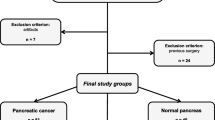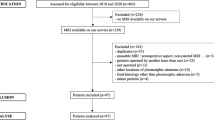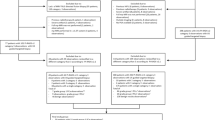Abstract
Background and purpose
The purpose of this study was to compare the diagnostic performance between apparent diffusion coefficient (ADC) analysis of one-point measurement and whole-tumor measurement, including radiomics for differentiating pleomorphic adenoma (PA) from carcinoma ex pleomorphic adenoma (CXPA), and to evaluate the impact of inter-operator segmentation variability.
Materials and methods
One hundred and fifteen patients with PA and 22 with CXPA were included. Four radiologists with different experience independently placed one-point and whole-tumor ROIs and a radiomics-predictive model was constructed from the extracted imaging features. We calculated the area under the receiver-operator characteristic curve (AUC) for the diagnostic performance of imaging features and the radiomics-predictive model.
Results
AUCs of the imaging features from whole-tumor varied between readers (0.50–0.89). The most experienced radiologist (Reader 1) produced significantly high AUCs than less experienced radiologists (Reader 3 and 4; P = 0.01 and 0.009). AUCs were higher for the radiomics-predictive model (0.82–0.87) than for one-point (0.66–0.79) in all readers.
Conclusion
Some imaging features of whole-tumor and radiomics-predictive model had higher diagnostic performance than one-point. The diagnostic performance of imaging features from whole-tumor alone varied depending on operator experience. Operator experience appears less likely to affect diagnostic performance in the radiomics-predictive model.




Similar content being viewed by others
Abbreviations
- ADC:
-
Apparent diffusion coefficient
- PA:
-
Pleomorphic adenoma
- CXPA:
-
Carcinoma ex pleomorphic adenoma
- ROI:
-
Region of interest
- ICC:
-
Intraclass correlation coefficient
- AUC:
-
Area under the receiver operating characteristic curve
- RF:
-
Random forest algorithm
- EN:
-
Elastic net algorithm
- CV:
-
Cross-validation
References
Eida S, Sumi M, Sakihama N, et al. Apparent diffusion coefficient mapping of salivary gland tumors: prediction of the benignancy and malignancy. AJNR Am J Neuroradiol. 2007;28(1):116–21.
Habermann CR, Arndt C, Graessner J, et al. Diffusion-weighted echo-planar MR imaging of primary parotid gland tumors: Is a prediction of different histologic subtypes possible? AJNR Am J Neuroradiol. 2009;30(3):591–6.
Matsushima N, Maeda M, Takamura M, et al. Apparent diffusion coefficients of benign and malignant salivary gland tumors. Comparison to histopathological findings. J Neuroradiol. 2007;34(3):183–9.
Yabuuchi H, Matsuo Y, Kamitani T, et al. Parotid gland tumors: Can addition of diffusion-weighted MR imaging to dynamic contrast-enhanced MR imaging improve diagnostic accuracy in characterization? Radiology. 2008;249(3):909–16.
El-Naggar AK, Chan JKC, Grandis JR, et al. World health organization classification of tumours of head and neck. Lyon: IARC; 2017.
Kato H, Kanematsu M, Mizuta K, Ito Y, et al. Carcinoma ex pleomorphic adenoma of the parotid gland: radiologic-pathologic correlation with MR imaging including diffusion-weighted imaging. AJNR Am J Neuroradiol. 2008;29(5):865–7.
Kashiwagi N, Murakami T, Chikugo T, et al. Carcinoma ex pleomorphic adenoma of the parotid gland. Acta Radiol. 2012;53(3):303–6.
Das DK, Petkar MA, Al-Mane NM, et al. Role of fine needle aspiration cytology in the diagnosis of swellings in the salivary gland regions: a study of 712 cases. Med Princ Pract. 2004;13(2):95–106.
Nouraei SAR, Hope KL, Kelly CG, et al. Carcinoma ex benign pleomorphic adenoma of the parotid gland. Plast Reconstr Surg. 2005;116(5):1206–13.
Klijanienko J, El-Naggar AK, Vielh P. Fine-needle sampling findings in 26 carcinoma ex pleomorphic adenomas: diagnostic pitfalls and clinical considerations. Diagn Cytopathol. 1999;21(3):163–6.
Rossi ED, Wong LQ, Bizzarro T, et al. The impact of FNAC in the management of salivary gland lesions: institutional experiences leading to a risk-based classification scheme. Cancer Cytopathol. 2016;124(6):388–96.
Gillies RJ, Kinahan PE, Hricak H. Radiomics: images are more than pictures, they are data. Radiology. 2016;278(2):563–77.
Suh HB, Choi YS, Bae S, et al. Primary central nervous system lymphoma and atypical glioblastoma: differentiation using radiomics approach. Eur Radiol. 2018;32(Suppl 5):984–8.
Kirienko M, Cozzi L, Antunovic L, et al. Prediction of disease-free survival by the PET/CT radiomic signature in non-small cell lung cancer patients undergoing surgery. Eur J Nucl Med Mol Imaging. 2017;45(2):1–11.
Parmar C, Grossmann P, Rietveld D, et al. Radiomic machine-learning classifiers for prognostic biomarkers of head and neck cancer. Front Oncol. 2015;5:272.
Brouwer CL, Steenbakkers RJ, van den Heuvel E, et al. 3D Variation in delineation of head and neck organs at risk. Radiat Oncol. 2012;7(1):32.
Matea P, Marta B, Xaver W, et al. Influence of inter-observer delineation variability on radiomics stability in different tumor sites. Acta Oncol. 2018;57(8):1070–4.
Ren J-L, Yuan Y, Li X-X, et al. Histogram analysis of apparent diffusion coefficient maps in the prognosis of patients with locally advanced head and neck squamous cell carcinoma_ Comparison of different region of interest selection methods. Eur J Radiol. 2018;106:7–13.
Nioche C, Orlhac F, Boughdad S, et al. LIFEx: a freeware for radiomic feature calculation in multimodality imaging to accelerate advances in the characterization of tumor heterogeneity. Cancer Res. 2018;78(16):4786–9.
Zou H, Hastie T. Regularization and variable selection via the elastic net. J R Stat Soc. 2005;67(2):301–20.
Motoori K, Yamamoto S, Ueda T, et al. Inter- and intratumoral variability in magnetic resonance imaging of pleomorphic adenoma: an attempt to interpret the variable magnetic resonance findings. J Comput Assist Tomogr. 2004;28(2):233–46.
Ma G, Zhu L, Su G, et al. Histogram analysis of apparent diffusion coefficient maps for differentiating malignant from benign parotid gland tumors. Eur Arch Otorhinolaryngol. 2018;275(8):2151–7.
Fruehwald-Pallamar J, Czerny C, Holzer-Fruehwald L, et al. Texture-based and diffusion-weighted discrimination of parotid gland lesions on MR images at 3.0 Tesla. NMR Biomed. 2013;26(11):1372–9.
Baltzer PAT, Kaiser WA, Dietzel M. Lesion type and reader experience affect the diagnostic accuracy of breast MRI: a multiple reader ROC study. Eur J Radiol. 2015;84(1):86–91.
Author information
Authors and Affiliations
Corresponding author
Ethics declarations
Conflict of interest
The authors declare that they have no conflict of interest.
Ethical statement
This study was approved by the local ethics review board and informed consent was waived due to the retrospective nature of this study.
Additional information
Publisher's Note
Springer Nature remains neutral with regard to jurisdictional claims in published maps and institutional affiliations.
Electronic supplementary material
Below is the link to the electronic supplementary material.
About this article
Cite this article
Wada, T., Yokota, H., Horikoshi, T. et al. Diagnostic performance and inter-operator variability of apparent diffusion coefficient analysis for differentiating pleomorphic adenoma and carcinoma ex pleomorphic adenoma: comparing one-point measurement and whole-tumor measurement including radiomics approach. Jpn J Radiol 38, 207–214 (2020). https://doi.org/10.1007/s11604-019-00908-1
Received:
Accepted:
Published:
Issue Date:
DOI: https://doi.org/10.1007/s11604-019-00908-1




